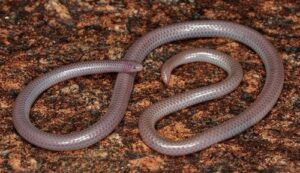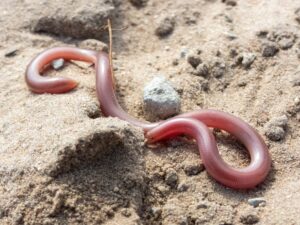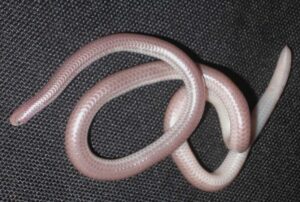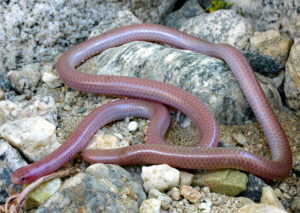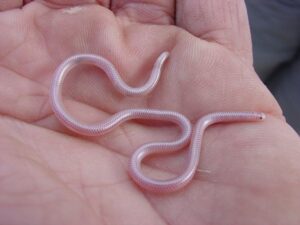The western blind snake, also known by the names western slender blind snake and western threadsnake, is a native of southwestern US and northern Mexico. The secretive, nocturnal and primitive species resembles a long earthworm in its looks and thickness. It is mostly active from April to August.
Scientific Classifications
- Suborder:Serpentes
- Family:Leptotyphlopidae
- Genus:Rena
- Species:R. humilis
Conservation Status
Subspecies
The snake has six recognized subspecies.
- Desert blind snake (Rena humilis cahuilae)
- Southwestern blind snake (Rena humilis humilis)
- Rena humilis levitoni
- Rena humilis lindsayi
- Rena humilis tenuiculus
- Utah blind snake (Rena humilis utahensis)
Description
Size
The adults attain a total length of less than 12 in (30 cm).
Color and Appearance
As the name suggests, its eyes are of no use as it lives underground. So though the black eyespots can detect light, they are mainly vestigial. It also has vestigial femurs that can be traced back to its lizard ancestors. The ground color is purple, pink, or silver-brown. The shiny, worm-like body is cylindrical and blunt at both ends. The thick skull permits burrowing, and the spine at the end of the tail is used for leverage. There is only one scale between the ocular scales on top of the head. The body is fluorescent in low-frequency UV light (black light).
Are They Dangerous to Humans
When disturbed, the harmless snake writhes and wiggles its tail focusing attention there instead of the head. When threatened, it coils up tightly and empties its bowels. It may try to poke the attacker with its tail spur or roll over and play dead. Its mouth is too small to deliver a bite.
Western Blind Snakes at a Glance
Distribution
In the US, it ranges from Trans-Pecos and southwestern Texas west through central and southern Arizona, southwestern Utah, southern Nevada, and southern California. In Mexico, it occurs in the states of Baja California, Sinaloa, Sonora, Nayarit, Jalisco, Chihuahua, Colima, Durango, Tamaulipas, Coahuila, and San Luis Potosí. The type locality of the species is Vallecito, California.
Habitat
The western blind snake is found in scrub and deserts where the soil is loose enough to burrow. It lives underground, sometimes as deep down as 66ft (20 m). The species is known to invade termite and ant nests.
Lifespan
To date, its lifespan is unknown.
Predators
The serpent is preyed upon by various animals, including birds, other snakes, fish, mammals, and even spiders.
Diet
Its diet is made up of insects, their larvae and eggs, mostly
Reproduction
Oviparous (lays eggs that hatch outside the body)
Clutches of around 2-6 eggs are laid in late summer, sometimes in communal nests. The hatchlings are 3.5 in (0.3 ft) in size.
Source
nocookie.net, ndow.org, a-z-animals.com, inaturalist.iu i.pinimg.com

